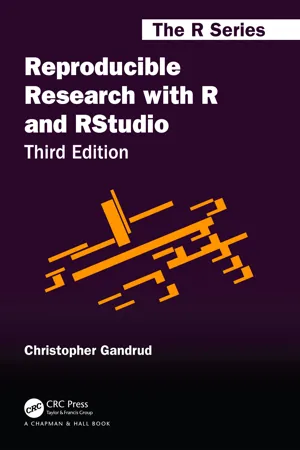
- 276 pages
- English
- ePUB (mobile friendly)
- Available on iOS & Android
Reproducible Research with R and RStudio
About this book
Praise for previous editions:
" Gandrud has written a great outline of how a fully reproducible research project should look from start to finish, with brief explanations of each tool that he uses along the way… Advanced undergraduate students in mathematics, statistics, and similar fields as well as students just beginning their graduate studies would benefit the most from reading this book. Many more experienced R users or second-year graduate students might find themselves thinking, 'I wish I'd read this book at the start of my studies, when I was first learning R!'…This book could be used as the main text for a class on reproducible research …" ( The American Statistician)
Reproducible Research with R and R Studio, Third Edition brings together the skills and tools needed for doing and presenting computational research. Using straightforward examples, the book takes you through an entire reproducible research workflow. This practical workflow enables you to gather and analyze data as well as dynamically present results in print and on the web. Supplementary materials and example are available on the author's website.
New to the Third Edition
-
- Updated package recommendations, examples, URLs, and removed technologies no longer in regular use.
-
- More advanced R Markdown (and less LaTeX) in discussions of markup languages and examples.
-
- Stronger focus on reproducible working directory tools.
-
- Updated discussion of cloud storage services and persistent reproducible material citation.
-
- Added discussion of Jupyter notebooks and reproducible practices in industry.
-
- Examples of data manipulation with Tidyverse tibbles (in addition to standard data frames) and pivot_longer() and pivot_wider() functions for pivoting data.
Features
-
- Incorporates the most important advances that have been developed since the editions were published
-
- Describes a complete reproducible research workflow, from data gathering to the presentation of results
-
- Shows how to automatically generate tables and figures using R
-
- Includes instructions on formatting a presentation document via markup languages
-
- Discusses cloud storage and versioning services, particularly Github
-
- Explains how to use Unix-like shell programs for working with large research projects
Frequently asked questions
- Essential is ideal for learners and professionals who enjoy exploring a wide range of subjects. Access the Essential Library with 800,000+ trusted titles and best-sellers across business, personal growth, and the humanities. Includes unlimited reading time and Standard Read Aloud voice.
- Complete: Perfect for advanced learners and researchers needing full, unrestricted access. Unlock 1.4M+ books across hundreds of subjects, including academic and specialized titles. The Complete Plan also includes advanced features like Premium Read Aloud and Research Assistant.
Please note we cannot support devices running on iOS 13 and Android 7 or earlier. Learn more about using the app.
Information
Part I
Getting Started
1
Introducing Reproducible Research
1.1 What Is Reproducible Research?
1.2 Why Should Research Be Reproducible?
1.2.1 For science
Standard to judge scientific claims
Avoiding effort duplication and encouraging cumulative knowledge development
Table of contents
- Cover
- Half Title
- Series Page
- Title Page
- Copyright Page
- Table of Contents
- Preface
- About the Author
- Stylistic Conventions
- Additional Resources
- I Getting Started
- II Data Gathering and Storage
- III Analysis and Results
- IV Presentation Documents
- Bibliography
- Index